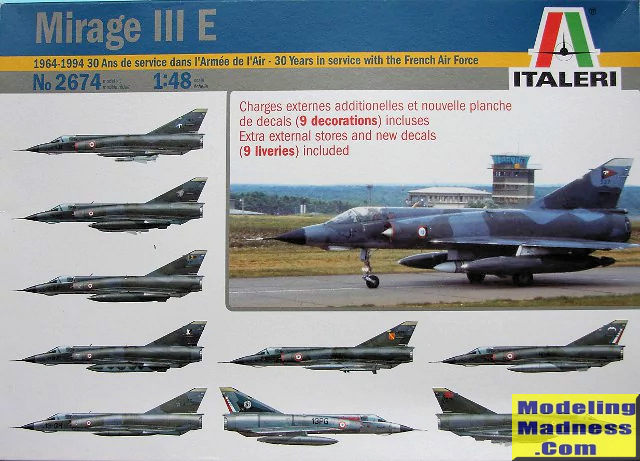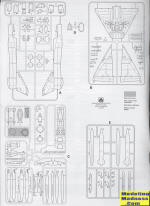
Italeri 1/48 Mirage IIIE
| KIT #: | 2674 |
| PRICE: | $20.00 or so from an auction |
| DECALS: | Nine options |
| REVIEWER: | Scott Van Aken |
| NOTES: |

| HISTORY |
While the Mirage IIIC was being put into production, Dassault was also considering a multirole/strike variant of the aircraft, which eventually materialized as the Mirage IIIE. The first of three prototypes flew on 1 April 1961.
The Mirage IIIE differed from the IIIC interceptor most obviously in having a 300 mm (11.8 in) forward fuselage extension to increase the size of the avionics bay behind the cockpit. The stretch also helped increase fuel capacity, as the Mirage IIIC had marginal range and improvements were needed. The stretch was small and hard to notice, but the clue is that the bottom edge of the canopy on a Mirage IIIE ends directly above the top lip of the air intake, while on the IIIC it ends visibly back of the lip.
Many Mirage IIIE variants were also fitted with a Marconi continuous-wave Doppler navigation radar radome on the bottom of the fuselage, under the cockpit. However, while no IIICs had this feature, it was not universal on all variants of the IIIE. A similar inconsistent variation in Mirage fighter versions was the presence or absence of an HF antenna that was fitted as a forward extension to the vertical tailplane. On some Mirages, the leading edge of the tailplane was a straight line, while on those with the HF antenna the leading edge had a sloping extension forward. The extension appears to have been generally standard on production Mirage IIIAs and Mirage IIICs, but only appeared in some of the export versions of the Mirage IIIE.
The IIIE featured Thompson-CSF Cyrano II dual mode air / ground radar; a radar warning receiver (RWR) system with the antennas mounted in the vertical tailplane; and an Atar 09C engine, with a petal-style variable exhaust.
The first production Mirage IIIE was delivered to the AdA in January 1964, and a total of 192 were eventually delivered to that service.
Total production of the Mirage IIIE, including exports, was substantially larger than that of the Mirage IIIC, including exports, totaling 523 aircraft. In the mid-1960s one Mirage IIIE was fitted with the improved SNECMA Atar 09K-6 turbojet for trials, and given the confusing designation of Mirage IIIC2. Most Mirage IIIE aircraft are now gone from the world's air forces though some are still plying the skies from time to time after having undergone various upgrades.
| THE KIT |
 One
of the things that ESCI produced was a very nice Mirage IIIE, and since Italeri
has the molds it is not surprising to see it in Italeri boxes. This is a
somewhat special boxing that commemorates 30 years of French operations. As such
you get some additional sprues not in the ESCI kit along with a killer decal
sheet.
One
of the things that ESCI produced was a very nice Mirage IIIE, and since Italeri
has the molds it is not surprising to see it in Italeri boxes. This is a
somewhat special boxing that commemorates 30 years of French operations. As such
you get some additional sprues not in the ESCI kit along with a killer decal
sheet.
Molded in grey plastic with finely done raised panel lines, this particular boxing is free of flash and though it does suffer a bit from ejector pin marks, most of them seem easily removed. There is detail in the wheel wells and inner gear doors though this is a bit thick and so you'll find large sink areas on the outside of the main gear outer doors. I also found some rather hefty sink areas opposite ejector towers in the fuselage nose area.
The interior consists of a cockpit tub, rather generic looking seat and control column. The instrument panel and consoles are smooth and the instruments represented by decals, a standard feature on all ESCI kits of the time. Wings have the control surfaces molded in the top half making for a sharp trailing edge. The leading edge of the upper wings show large sink areas that will need filled. The elevon actuators are separate as are the various fuselage scoops. The exhaust is only really as deep as the afterburner petals so you may want to drill this out, insert some tubing and engine detail. Two high speed drop tanks are provided for the wing pylons and the central pylon contains a Matra missile. All of the possible pylon holes are already opened up so if you don't want a certain item attached, the hole will need to be filled.
 What you get
in addition on this kit are some sprues from other ESCI Mirage boxings. This
includes outer wing pylons and Sidewinders, a centerline rack for holding a pair
of bombs or a large fuel tank, and a different centerline missile. There are
some bits not used including a leading edge fin extension so you might want to
save that for any other ESCI Mirage IIIs you might have.
What you get
in addition on this kit are some sprues from other ESCI Mirage boxings. This
includes outer wing pylons and Sidewinders, a centerline rack for holding a pair
of bombs or a large fuel tank, and a different centerline missile. There are
some bits not used including a leading edge fin extension so you might want to
save that for any other ESCI Mirage IIIs you might have.
Instructions are well done and provide good construction steps along with Italian Model Master paint references. There are nine options, all but one of which are in green/dark grey over light grey. The instructions suggestion FS 34079 for the green, 36231 for the dark grey, and 36475 for the underside shade. There is a lone unpainted metal option. The majority of options are for the late 1980s and early 1990s, after the French roundel lost its yellow surround. The decal sheet is superbly done and you are provided load-out information for all of the options provided.
| CONCLUSIONS |
I built this same basic kit in the ESCI or Revell box a couple of times and it is a fairly trouble-free build, though by no means Tamiya engineering. It can use cockpit enhancements, as can pretty much any kit of this vintage, so at least getting a better seat would be a good idea. The kit was released in 2008 and is still fairly available if one is so interested.
July 2019
Copyright ModelingMadness.com. All rights reserved.
If you would like your product reviewed fairly and fairly quickly, please contact the editor or see other details in the Note to Contributors.